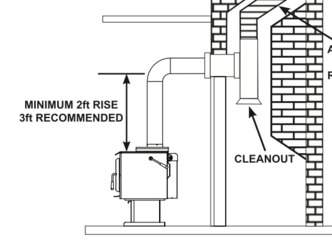Jotul vs Blaze King vs Vermont Castings Wood Stove?
- Thread starter Hexa Fox
- Start date
-
Active since 1995, Hearth.com is THE place on the internet for free information and advice about wood stoves, pellet stoves and other energy saving equipment.
We strive to provide opinions, articles, discussions and history related to Hearth Products and in a more general sense, energy issues.
We promote the EFFICIENT, RESPONSIBLE, CLEAN and SAFE use of all fuels, whether renewable or fossil.
You are using an out of date browser. It may not display this or other websites correctly.
You should upgrade or use an alternative browser.
You should upgrade or use an alternative browser.
It does not really effect me though right? The hearth should take care of all that. My worst nightmare is getting one of these stoves and having major issues with it. It is my primary and really going to be my sole heat source so I cannot afford a major issue.Take note of rear clearances of any stove you consider. A heat shield behind the stove and stove pipe can reduce clearances even further, but in some instances, for whatever reasons, people may not want to install a heat shield behind the stove.
I only mention that because the Woodstock stoves may need slightly more clearance if I recall correctly. Just be aware this is something you may want to pay attention to.I don’t for see anything with that install, nut you never know.
So just pointing out that Blaze King and even others have totally contradicted this. Blaze King told me that 16" splits are recommended in the stove and that you could squeeze 18" splits in it but it was not recommended. So 22" seems like a bit much from what I have been hearing?Not sure if it was already mentioned. Did not read the whole post. The Princess will take 22” splits e/w.
Ashful
Minister of Fire
16-18" is recommended, because you can load them north-south, which allows better and fuller loading without logs rolling out.So just pointing out that Blaze King and even others have totally contradicted this. Blaze King told me that 16" splits are recommended in the stove and that you could squeeze 18" splits in it but it was not recommended. So 22" seems like a bit much from what I have been hearing?
But if you have some wood that is already cut to 22", then I suppose Diabel is pointing out that you can burn by loading east-west. Not preferred, due to logs trying to roll out or up against the door, but do-able.
Do you have any idea what is behind the hearth? Clearance to combustibles? Air gap behind the bricks?It does not really effect me though right? The hearth should take care of all that. My worst nightmare is getting one of these stoves and having major issues with it. It is my primary and really going to be my sole heat source so I cannot afford a major issue.
👍16-18" is recommended, because you can load them north-south, which allows better and fuller loading without logs rolling out.
But if you have some wood that is already cut to 22", then I suppose Diabel is pointing out that you can burn by loading east-west. Not preferred, due to logs trying to roll out or up against the door, but do-able.
Well the hearth is mostly underground and the brick work is still in pretty great shape considering how old it is. The wall side is in especially good shape. The chimney side goes out into a flower bed, so nothing to worry about there. So I think this house was built in 1985 and the chimney was added at that time. So it is coming up on being forty years old.Do you have any idea what is behind the hearth? Clearance to combustibles? Air gap behind the bricks?
If I worry about something other than the wood stove and liner it is going to be the crown. I am no expert but if you look at this picture you can see the mortar added was pretty much inadequate from the beginning or maybe it has worn over the near forty years. Just you can see it looks like whoever did it made it purposefully stop short. There is no obviously place where any of it has broken off so I guess I should consider myself lucky. I got one estimate to redo the crown while he was here. He said he would do it for $500 along with the other work which I find a little steep. I would imagine it costing that much if you had to make the trip and that was the only thing you were doing. Anyway I have at least three others coming out to give estimates. One of them is also a Blaze King dealer but cannot be here until October 13th.
The big concern is that as others have mentioned I am going to be growing shorter and shorter on time and have decisions to make. I talked to Blaze King again and asked them about clearances etc and they said their "wood stoves do require good setups to be efficient". One thing I like is the honesty. The rep told me that indeed my best bet was going to be the Princess. She said they recommended that the stove pipe coming up off the actual stove go straight up 36" before taking any kind of turn. Accounting for some of the legs and pedestal with the Princess I am about 12" short of that. She also said that the recommended chimney height was 15'-30' with 15' obviously being the bare minimum after you account for horizontal pipe or turns.
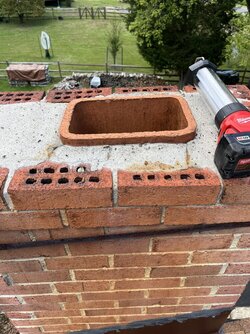
Ashful
Minister of Fire
Yeah, the core bricks should go. Not sure what someone was thinking, using them like that, but if the bedding mortar below them is solid, at least that's keeping water from going further than that core itself.
Crowns are not forever, they need to be touched up and replaced more than any other part of the chimney. Even if there are no obvious stability issues, try to get them checked at least once every 10 years.
Crowns are not forever, they need to be touched up and replaced more than any other part of the chimney. Even if there are no obvious stability issues, try to get them checked at least once every 10 years.
Yeah like I said this one has been like this from 1985 so I consider myself lucky. I just had a guy look at it and he said minor work but it definitely needed to be addressed.Yeah, the core bricks should go. Not sure what someone was thinking, using them like that, but if the bedding mortar below them is solid, at least that's keeping water from going further than that core itself.
Crowns are not forever, they need to be touched up and replaced more than any other part of the chimney. Even if there are no obvious stability issues, try to get them checked at least once every 10 years.
Anyway since this is my wood stove forum I just had a local very highly recommended guy come out and take a look. He was extremely knowledgeable and he already knew a lot about the wood stoves like Blaze King even though he is not a dealer. He said that other stoves like Regency do not have the requirements that the Blaze King stoves do. For instance, he mentioned that I was already under the minimum requirements for a Blaze King and was against it. He knew about the chimney height and the 36" from the stove top.
I realize people are going to try to get you what they are selling but he told me to keep looking at and talk to Regency. He said they do not have the same requirements. He is a dealer for Regency and he said they are very, very nice stoves. He said I could even go with a T2500 over the T3500. He made a great point on that if something happens or you have an issue the first thing a manufacturer is going to ask is if you met requirements like these. So I may talk to Regency today if they have a customer service line.
Ashful
Minister of Fire
Worth discussing. This is really simple physics, and no stove or manufacturer can break physics.He said that other stoves like Regency do not have the requirements that the Blaze King stoves do.
Blaze King has made a market for themselves by really pushing the envelope on super long burn times. And if you want to play in that club, bragging here next year about your 30+ hour burn times, you do need a pretty good setup to support that. The ability to properly draft the stove with a good chimney has direct bearing on the "stall point", essentially how low you can run the thing before it stalls and dies.
At the other extreme, you could install and run a Blaze King on the same marginal chimney as most others. There is absolutely no technical problem with that, but you're cutting its legs out from under it, removing its ability to do the one thing that made you buy (and maybe pay more for) this brand. As others have already said in other threads, don't bother buying a Blaze King, if you intend to only ever run it like a non-cat. It's just a waste.
Somewhere between these two extremes is where the rest of us in the real world land. We might not have an "ideal" chimney, but we have something good enough to allow us to push the thing lower than we might reach with other brands, and we call that compromise.
Thanks I just sent some information out to several people so far. She definitely said 36" over the phone and probably cause well, that is what is recommended lol. My cheapest and perhaps best option is to try to do this myself with someone helping me and maybe even getting my own stove. For instance, I could probably save a lot of money by getting and insulating the liner myself and buying an Ideal Steel from Woodstock. That way I would also be putting in whatever liner I decided to purchase.
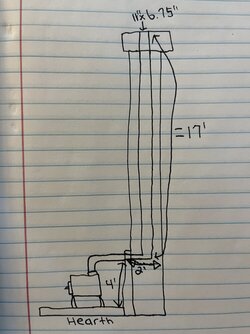
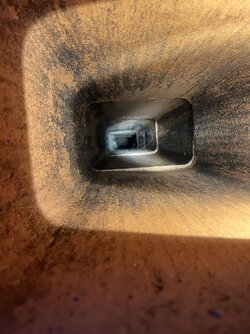
It’s going to be tough to reline that chimney with a 6.75” width. Your probably going to have to bust out the tiles especially if you insulate the liner which is highly recommended. Maybe you could fit an ovalized liner down there?
An oval liner will do it. Duraliner oval is pre-insulated and comes in at 4 3/4" x 7 3/4".It’s going to be tough to reline that chimney with a 6.75” width. Your probably going to have to bust out the tiles especially if you insulate the liner which is highly recommended. Maybe you could fit an ovalized liner down there?
Okay so I know you did not put 'absolutes' on anything but having my situation in mind do you (and others) think I should avoid a catalytic stove all together or just the Blaze King's because of their requirements?Worth discussing. This is really simple physics, and no stove or manufacturer can break physics.
Blaze King has made a market for themselves by really pushing the envelope on super long burn times. And if you want to play in that club, bragging here next year about your 30+ hour burn times, you do need a pretty good setup to support that. The ability to properly draft the stove with a good chimney has direct bearing on the "stall point", essentially how low you can run the thing before it stalls and dies.
At the other extreme, you could install and run a Blaze King on the same marginal chimney as most others. There is absolutely no technical problem with that, but you're cutting its legs out from under it, removing its ability to do the one thing that made you buy (and maybe pay more for) this brand. As others have already said in other threads, don't bother buying a Blaze King, if you intend to only ever run it like a non-cat. It's just a waste.
Somewhere between these two extremes is where the rest of us in the real world land. We might not have an "ideal" chimney, but we have something good enough to allow us to push the thing lower than we might reach with other brands, and we call that compromise.
I do appreciate all the feedback and honesty I have found here. I am just trying to make the right decision the first time, because as I said before there is no room for error with this being my primary heat source.
This. I talked to Eric from rockfordchimneysupply.com and he said 5" x 8.15" would put me around 6" x 9.15" with the liner insulated. He also mentioned 4.5" x 9.1" but he said before he said anymore he wanted to know some other specifics. I plan to talk to him today or tomorrow hopefully.An oval liner will do it. Duraliner oval is pre-insulated and comes in at 4 3/4" x 7 3/4".
I don't think they sell DuraLiner which is a rigid liner system.This. I talked to Eric from rockfordchimneysupply.com and he said 5" x 8.15" would put me around 6" x 9.15" with the liner insulated. He also mentioned 4.5" x 9.1" but he said before he said anymore he wanted to know some other specifics. I plan to talk to him today or tomorrow hopefully.
Ashful
Minister of Fire
I think you can't go wrong with the Blaze King in this case, because:Okay so I know you did not put 'absolutes' on anything but having my situation in mind do you (and others) think I should avoid a catalytic stove all together or just the Blaze King's because of their requirements?
I do appreciate all the feedback and honesty I have found here. I am just trying to make the right decision the first time, because as I said before there is no room for error with this being my primary heat source.
- You have 17 feet above the elbow + 4 feet below. Subtract maybe 1 ft for hearth up to bottom of stove, and you have an effective 20 feet of chimney, before subtracting the effect of elbows. This buys you margin.
- I have 15 feet of insulated pipe on one of my Ashford 30's, straight up, and it's a nearly-ideal setup in cold weather. It's a touch under-drafted in warm weather, but it always works once warmed, and is ideal when it gets cold.
- Even if the resulting setup is less than ideal, you'll be no worse with the Blaze King than any other model. As I was explaining in post #37, a non-ideal setup reduces the advantages you can pull out of a Blaze King, but a non-ideal setup doesn't somehow make that stove worse than others.
He got my information and I just spoke to him. He recommended going with a rectangle liner. This is the one he sent. He said it is .006 thick which referring to the information @bholler posted is pretty light duty/corrugated material. Also confirms your post as well. Regardless Eric from rockfordchimneysupply.com has been very professional. This setup all together, even with the installation and stove pipe would run me approximately $2,000.I don't think they sell DuraLiner which is a rigid liner system.
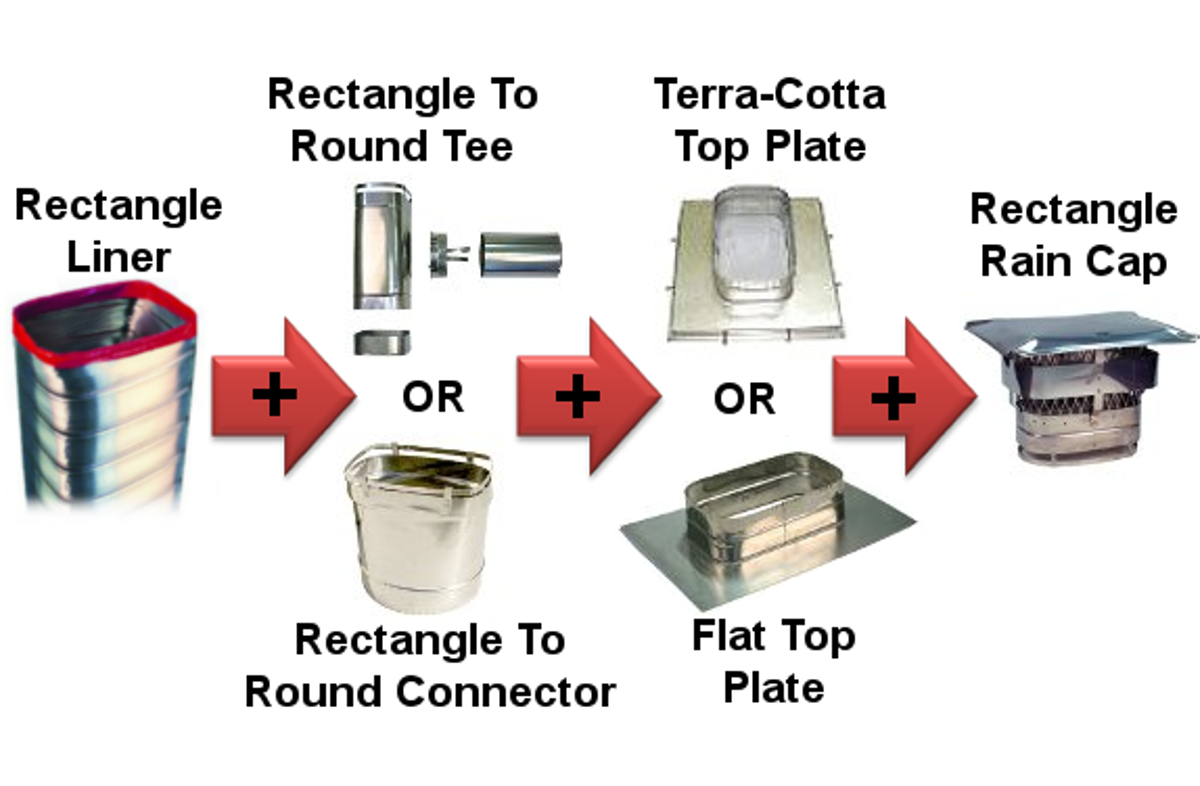
Rectangle Chimney Liner Kits - Rectangle Flex Stainless Steel Liner Kits - Rockford Chimney
Shop rectangular chimney liner kits. Rectangle chimney flue pipe kits made with flexible 316Ti stainless steel. Shaped chimney liner calculator & DIY guide.
Why did they recommend rectangle? That is oddHe got my information and I just spoke to him. He recommended going with a rectangle liner. This is the one he sent. He said it is .006 thick which referring to the information @bholler posted is pretty light duty/corrugated material. Also confirms your post as well. Regardless Eric from rockfordchimneysupply.com has been very professional. This setup all together, even with the installation and stove pipe would run me approximately $2,000.

Rectangle Chimney Liner Kits - Rectangle Flex Stainless Steel Liner Kits - Rockford Chimney
Shop rectangular chimney liner kits. Rectangle chimney flue pipe kits made with flexible 316Ti stainless steel. Shaped chimney liner calculator & DIY guide.www.rockfordchimneysupply.com
He got my information and I just spoke to him. He recommended going with a rectangle liner.
Agreed. How would that be better than 6" round? When insulated, it's going to bind.Why did they recommend rectangle? That is odd
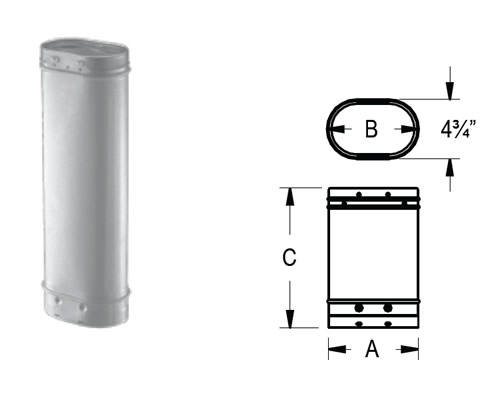
Home :: Chimney Pipe / Venting Pipe :: Wood/All-Fuel Piping :: 6 inch :: DuraVent DuraLiner 6 :: DuraVent 6'' DuraLiner Oval Rigid Pipe 48'' - 4648-OP // 6DLR-48O
M&G DuraVent 6" DuraLiner Oval Rigid Pipe 48" - 4648-OPFactory insulated, Oval Rigid Pipe is available in 6" and 8" diameters; 12", 24", 36", and 48" lengths. Insulated. Built-in pre drilled fittings for riveting joints. UL Listed for zero clearance betwe
A 6" equivalent rectangle is only about 4.5 x 9 or so. So it would fit. But rectangle costs more than oval doesn't draft as well and isn't as flexible. Just doesn't make sense to me.How would that be better than 6" round? When insulated, it's going to bind.
Similar threads
- Replies
- 10
- Views
- 959
- Replies
- 17
- Views
- 2K
- Replies
- 8
- Views
- 2K
- Replies
- 52
- Views
- 5K


